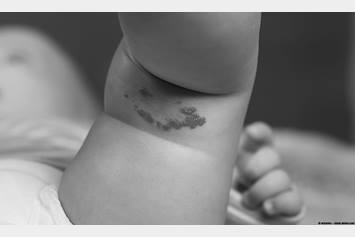Birthmarks
What is a Birthmark?
A birthmark is a colored spot on the skin, which is present at the time of birth or develops shortly after. Birthmarks range in color from tan or brown to black or blue, or even bright red. They can be as small as a freckle or involve large areas of the face, body, arms or legs.
What Causes Birthmarks?
Most birthmarks form by chance alone and are not linked to other medical problems. Some specific types of birthmarks, however, can be part of a larger collection of problems called a syndrome. Birthmarks are not caused by anything that mothers did or didn’t do while pregnant, nor are they caused by birth trauma.
DOES YOUR CHILD NEED TO BE SEEN BY OUR EXPERTS?
Use our secure online form to request an appointment or get a second opinion. An appointment scheduler will contact you by phone within 24 hours.
What are the Types of Birthmarks?
There are many different types of birthmarks, but most can be placed into one of two categories:
-
Vascular: from blood vessels
-
Pigmented: from cells that control skin color
Vascular Birthmarks
Macular Stains
One out of every three babies is born with a macular stain, making it the most common type of vascular birthmark. They are also known as an “angel kiss,” “stork bite” or “salmon patch.” A macular stain is a flat, pink blotchy area of skin that commonly occurs on the eyelids, scalp or neck. These birthmarks cause no problems and most fade completely by 18 months of age.
Hemangiomas
Hemangiomas are collections of abnormal blood vessels that can form anywhere in the body. Two to five percent of babies are born with a hemangioma or develop one within the first two months of life. Sometimes called “strawberry marks,” hemangiomas involving the skin may first appear as small red bumps or patches. They tend to grow rapidly for the first year and then slowly shrink over time without treatment. Most hemangiomas leave little trace by 5-10 years of age. For this reason, surgery to remove a hemangioma is rarely needed.
Some hemangiomas can cause problems if they bleed or press on important nearby structures, such as the eye or the upper airway. In these high-risk situations, medications are prescribed to help rapidly decrease the size of the hemangioma. These medications have risks and side effects of their own, so treatment is reserved for hemangiomas that are truly high-risk.
Babies with multiple hemangiomas of the skin may also have internal hemangiomas, in the belly, for example. Large hemangiomas on the face or middle of the back may be related to other problems, such as heart defects or spinal abnormalities. Your child’s doctor can help recognize these types of hemangiomas and perform further testing, when necessary.
Port Wine Stains
Port wine stains, also known as capillary malformations, are flat, pink or red patches of skin caused by abnormal capillaries (the tiniest blood vessels) within the skin. Three in every 1,000 babies are born with a port wine stain. Unlike hemangiomas, port wine stains grow slowly with the child and do not go away over time. Instead, they tend to become darker and may develop a thickened, “cobblestoned” appearance without treatment. Laser therapy can be helpful to lighten the color of port wine stains and prevent them from thickening.
Babies with large port wine stains of the face may be at increased risk for eye problems, seizures and developmental delay (Sturge-Weber syndrome). Your child’s doctor can help decide when a port wine stain requires further workup.
Pigmented Birthmarks
Congenital Melanocytic Nevi
Congenital melanocytic nevi (CMN) are “moles” that are present at birth. They range in color from light brown to black and come in all shapes and sizes. Over time, CMN may darken, thicken or grow hair. One percent of babies are born with a CMN, but so-called “giant” CMN are much less common (1 in 50,000).
While the risk is higher in larger CMN, any mole can change into a serious type of skin cancer called melanoma. Check your child’s moles periodically and notify his or her pediatrician about changes. Small moles may require surgical removal if there is concern for melanoma. Very large or giant CMN often require multiple stages of removal and reconstructive surgery to remove as much of the abnormal skin as possible, reducing the cancer risk and improving appearance.
Dermal Melanosis
Commonly referred to as “Mongolian spots,” dermal melanoses are flat, bluish-gray areas of skin that may look almost like bruises. They frequently occur on the lower back or buttocks of darker skinned babies and most fade completely by two years of age. Dermal melanoses are harmless and do not require any treatment.
Café-au-lait Spots
True to their name, these flat spots are the color of coffee with milk. Twenty percent to 50 percent of newborn babies have one or more café-au-lait spots. They may increase in size and number over time, but unlike moles, carry no increased risk of skin cancer.
No treatment is necessary, but children with many café-au-lait spots should be checked for a syndrome called NF-1 (neurofibromatosis-1), which is associated with abnormal growth of nerve tissues throughout the body.
How are Birthmarks Treated?
It is important to have all birthmarks evaluated by your child’s doctor, even though most are harmless and do not require treatment.

